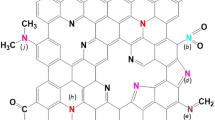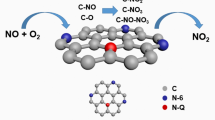Abstract
Selective doping of nitrogen into carbon materials in the absence of catalysts is a key for various applications of carbon materials. It is well known that most nitrogen-containing raw materials generate unnecessary functional groups during carbonization. Many researchers have noticed the significance of the selective nitrogen doping, whereas only a few works have reported the selective doping. In addition, those few works used catalysts to synthesize nitrogen-doped carbon materials, but the presence of catalysts limits the applications of nitrogen-doped carbon materials. This study found an unusual aromatic compound, imidazo[1,2-a]pyridine (IP), which maintained 88 % of the functional groups of as-received IP even after carbonization at 673 K in the absence of catalysts, and the functional groups were further maintained up to 773 K. The percentage of remaining functional groups was revealed using our state-of-the-art techniques of simulated X-ray photoelectron spectroscopy and Raman spectroscopy combined with transition state calculation using density functional theory. The low carbonization temperature as well as selective doping of nitrogen was achieved because of the low activation energy of dehydrogenation reaction among IP molecules compared to the high activation energy of radical formation for scission of C–N bonding.














Similar content being viewed by others
References
Shen W, Fan W (2013) Nitrogen-containing porous carbons: synthesis and application. J Mater Chem A 1:999–1013
Parambhath VB, Nagar R, Ramaprabhu S (2012) Effect of nitrogen doping on hydrogen storage capacity of palladium decorated graphene. Langmuir 28:7826–7833
Choi HJ, Jung SM, Seo JM, Chang DW, Dai L, Baek JB (2012) Graphene for energy conversion and storage in fuel cells and supercapacitors. Nano Energy 1:534–551
Wang H, Maiyalagan T, Wang X (2012) Review on recent progress in nitrogen-doped graphene: synthesis, characterization, and its potential applications. ACS Catal 2:781–794
Patel M, Feng W, Savaram K, Khoshi MR, Huang R, Sun J et al (2015) Microwave enabled one-pot, one-step fabrication and nitrogen doping of holey graphene oxide for catalytic applications. Small 11:3358–3368
Zhang L, Xia Z (2011) Mechanisms of oxygen reduction reaction on nitrogen-doped graphene for fuel cells. J Phys Chem C 115:11170–11176
Lv R, Terrones M (2012) Towards new graphene materials: doped graphene sheets and nanoribbons. Mater Lett 78:209–218
Daems N, Sheng X, Vankelecom FJI, Pescarmona PP (2014) Metal-free doped carbon materials as electrocatalysts for the oxygen reduction reaction. J Mater Chem A 2:4085–4110
Wang X, Hou Z, Ikeda T, Huang SF, Terakura K, Boero M et al (2011) Selective nitrogen doping in graphene: Enhanced catalytic activity for the oxygen reduction reaction. Phys Rev B 84:245434
Lv R, Li Q, Botello-Méndez AR, Hayashi T, Wang B, Berkdemir A et al (2012) Nitrogen-doped graphene: beyond single substitution and enhanced molecular sensing. Sci Rep 2:586
Shafeeyan MS, Daud WMAW, Houshmand A, Shamiri A (2010) A review on surface modification of activated carbon for carbon dioxide adsorption. J Anal Appl Pyrol 89:143–151
Yamada Y, Miyauchi M, Kim J, Hirose-Takai K, Sato Y, Suenaga K et al (2011) Exfoliated graphene ligands stabilizing copper cations. Carbon 49:3375–3378
Yamada Y, Suzuki Y, Yasuda H, Uchizawa S, Hirose-Takai K, Sato Y et al (2014) Functionalized graphene sheets coordinating metal cations. Carbon 75:81–94
Kundu S, Xia W, Busser W, Becker M, Schmidt DA, Havenith M et al (2010) The formation of nitrogen-containing functional groups on carbon nanotube surfaces: a quantitative XPS and TPD study. Phys Chem Chem Phys 12:4351–4359
Zhang LS, Liang XQ, Song WG, Wu ZY (2010) Identification of the nitrogen species on N-doped graphene layers and Pt/NG composite catalyst for direct methanol fuel cell. Phys Chem Chem Phys 12:12055–12059
Kumar A, Ganguly A, Papakonstantinou P (2012) Thermal stability study of nitrogen functionalities in a graphene network. J Phys: Condens Mater 24:235503
Pels JR, Kapteijn F, Moulijn JA, Zhu Q, Thomas KM (1995) Evolution of nitrogen functionalities in carbonaceous materials during pyrolysis. Carbon 33:1641–1653
Lu YF, Lo ST, Lin JC, Zhang W, Lu JY, Liu FH et al (2013) Nitrogen-doped graphene sheets grown by chemical vapor deposition: synthesis and influence of nitrogen impurities on carrier transport. ACS Nano 7:6522–6532
Walker PL Jr (1990) Carbon: an old but new material revisited. Carbon 28:261–279
Isaacs LG (1970) The graphitization of organic compounds-III. Heterocyclic nitrogen derivatives of anthracene and phenanthrene. Carbon 8:1–5
Kinney CR, Delbel E (1954) Pyrolytic behavior of unsubstituted aromatic hydrocarbons. Ind Eng Chem 46:548–556
Maldonado S, Morin S, Stevenson KJ (2006) Structure, composition, and chemical reactivity of carbon nanotubes by selective nitrogen doping. Carbon 44:1429–1437
Yasuda S, Yu L, Kim J, Murakoshi K (2013) Selective nitrogen doping in graphene for oxygen reduction reactions. Chem Commun 49:9627–9629
Yamada Y, Kim J, Matsuo S, Sato S (2014) Nitrogen-containing graphene analyzed by X-ray photoelectron spectroscopy. Carbon 70:59–74
Bieri M, Treier M, Cai J, Aït-Mansour K, Ruffieux P, Gröning O et al (2009) Porous graphenes: two-dimensional polymer synthesis with atomic precision. Chem Commun 45:6919–6921
Cai J, Ruffieux P, Jaafar R, Bieri M, Braun T, Blankenburg S et al (2010) Atomically precise bottom-up fabrication of graphene nanoribbons. Nature 466:470–473
Chen L, Hernandez Y, Feng X, Müllen K (2012) Nitrogenated holey two-dimensional structures. Angew Chem Int Ed 51:7640–7654
Bieri M, Blankenburg S, Kivala M, Pignedoli CA, Ruffieux P, Müllen K et al (2011) Surface-supported 2D heterotriangulene polymers. Chem Commun 47:10239–10241
Griffin RR, Scaroni AW, Walker PL Jr (1991) Cokes and graphites produced from anthracene, acridine, and phenazine. Carbon 29:991–998
Madison JJ, Roberts RM (1958) Pyrolysis of aromatics and related heterocyclics. Ind Eng Chem 50:237–250
Ruland W (1965) X-ray studies on the carbonization and graphitization of acenaphthylene and bifluorenyl. Carbon 2:365–378
Moraski GC, Markley LD, Chang M, Cho S, Franzblau SC, Hwang CH et al (2012) Generation and exploration of new classes of antitubercular agents: The optimization of oxazolines, oxazoles, thiazolines, thiazoles to imidazo[1,2-a]pyridines and isomeric 5,6-fused scaffolds. Bioorg Med Chem 20:2214–2220
Yamada Y, Yasuda H, Murota K, Nakamura M, Sodesawa T, Sato S (2013) Analysis of heat-treated graphite oxide by X-ray photoelectron spectroscopy. J Mater Sci 48:8171–8198
Kim J, Yamada Y, Kawai M, Tanabe T, Sato S (2015) Spectral change of simulated X-ray photoelectron spectroscopy from graphene to fullerene. J Mater Sci 50:6739–6747
Yamada Y, Sato S (2015) Structural analysis of carbon materials by X-ray photoelectron spectroscopy using computational chemistry. Tanso 269:181–189
Kim J, Yamada Y, Suzuki Y, Ciston J, Sato S (2014) Pyrolysis of epoxidized fullerenes analyzed by spectroscopies. J Phys Chem C 118:7076–7084
Briggs D, Grant JT (2003) Surface analysis by Auger and X-ray photoelectron spectroscopy. IMPublications and SurfaceSpectra Ltd., West Sussex and Manchester, pp 401–403
Frisch MJ, Trucks GW, Schlegel HB, Scuseria GE, Robb MA, Cheeseman JR et al (2009) Connecticut: Gaussian 09, Revision D.01. Gaussian Inc, Wallingford
Lewis IC, Edstrom T (1963) Thermal reactivity of polynuclear aromatic hydrocarbons. J Org Chem 28:2050–2057
Tanaka Y (2015) Analysis of pyrolytic process of nitrogen-containing aromatic compounds. Master Thesis, Chiba University
Brown MS, Jorio A, Corio P, Dresselhaus G, Dresselhaus G, Saito R, Kneipp K (2001) Origin of the Breit–Wigner–Fano lineshape of the tangential G-band feature of metallic carbon nanotubes. Phys Rev B 63:155414
Dresselhaus MS, Dresselhaus G, Saito R, Jorio A (2005) Raman spectroscopy of carbon nanotubes. Phys Rep 409:47–99
Sasaki K, Tokura Y, Sogawa T (2013) The origin of Raman D band: bonding and antibonding orbitals in graphene. Crystals 3:120–140
Ferrari AC, Robertson J (2004) Raman spectroscopy of amorphous, nanostructured, diamond-like carbon, and nanodiamond. Philos Trans R Soc Lond A 362:2477–2512
Schwan J, Ulrich S, Batori V, Ehrhardt H, Silva SRP (1996) Raman spectroscopy on amorphous carbon films. J Appl Phys 80:440–447
Eckmann A, Felten A, Mishchenko A, Britnell L, Krupke R, Novoselov KS, Casiraghi C (2012) Probing the nature of defects in graphene by Raman spectroscopy. Nano Lett 12:3925–3930
Schaffer HE, Chance RR, Silbey RJ, Knoll K, Schrock RR (1991) Conjugation length dependence of Raman scattering in a series of linear polyenes: implications for polyacetylene. J Chem Phys 94:4161–4170
Larkin PJ (2011) IR and Raman spectroscopy. Principles and spectral interpretation. Elsevier Inc, Amsterdam, pp 86–90
Colthup NB, Daly LH, Wiberley SE (1990) Introduction to infrared and Raman spectroscopy. Academic Press, Massachusetts, pp 261–279
Chen ZY, Zhao JP, Yano T, Ooie T, Yoneda M, Sakakibara J (2000) Observation of sp3 bonding in tetrahedral amorphous carbon using visible Raman spectroscopy. J Appl Phys 88:2305–2308
Dresselhaus MS, Dresselhaus G, Eklund PC (1996) Raman scattering in fullerenes. J Raman Spectrosc 27:351–371
Tarrant RN, Warschkow O, McKenzie DR (2006) Raman spectra of partially oriented sp2 carbon films: experimental and modelled. Vib Spectrosc 41:232–239
Colangeli L, Mennella V, Baratta GA, Bussoletti E, Strazzula G (1992) Raman and infrared spectra of polycyclic aromatic hydrocarbon molecules of possible astrophysical interest. Astrophys J 396:369–377
Acknowledgements
This work was funded by the Murata Science Foundation in Japan.
Author information
Authors and Affiliations
Corresponding author
Ethics declarations
Conflict of interest
The authors declare no competing financial interest.
Rights and permissions
About this article
Cite this article
Yamada, Y., Matsuo, S., Abe, K. et al. Selective doping of nitrogen into carbon materials without catalysts. J Mater Sci 51, 8900–8915 (2016). https://doi.org/10.1007/s10853-016-0142-y
Received:
Accepted:
Published:
Issue Date:
DOI: https://doi.org/10.1007/s10853-016-0142-y




